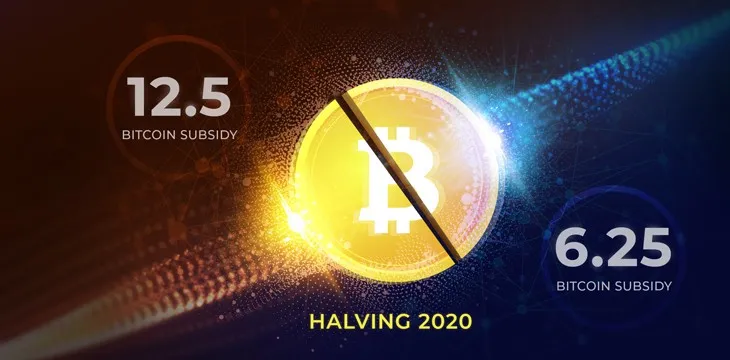|
Getting your Trinity Audio player ready...
|
Bitcoin works thanks to human economic incentives as much as its technology. Price goes up, activity and interest increases. In a bear market, it wanes. Transaction processors invest in the network and perform their jobs in order to make a profit. As the block reward “halving” approaches amid falling prices, these profits become ever more important—and the need for Bitcoin to scale massively on-chain becomes clear.
“Halving” refers to an event that occurs roughly every four years on Bitcoin (and its BTC and BCH derivatives). In return for confirming a block of transactions, processors (previously known as “miners“) receive a “reward” in the form of new bitcoins. From 2009-2012 this was 50 coins; from 2012-2016 it was 25 coins; since then it’s been 12.5. Between early April and May 2020, it halves again—to 6.25 coins.
You can read more on the rationale and potential effects of the halvings here and here, and watch live countdown timers for Bitcoin, BTC and BCH.
Market prices for Bitcoin (BSV), BTC and BCH are a factor when transaction processors decide which network their machines should run on. Politics aside, they are for-profit businesses and have large energy and maintenance expenses to pay. Many switch between the BSV, BTC and BCH networks regularly, based on which is more profitable at a given time. At the time of writing this article, it’s 33.7% more profitable to process transactions on BSV, and 21.0% more profitable on BCH, than on BTC (data source: Coin.dance).
But Bitcoin needs more than just block rewards and high prices to make profits for transaction processors, and incentivize them to continue their work. To explain this, we’ll need to go over some history.
Why the ‘Bitcoin scaling debate’ mattered so much
Why are there three networks calling themselves ‘Bitcoin’? Here’s a brief explanation. For years, a fierce debate raged over how Bitcoin should scale to the proportions necessary to support global demand. BTC, with its 1MB transaction block sizes, could handle a mere 3-7 transactions per second.
Two camps evolved. One (known as the “big blockers”) said the answer was simply to increase the transaction block size above 1MB—either gradually or right away. The other (aka “small blockers”) said Bitcoin blocks should stay at 1MB or become even smaller, with common transactions taking place on a completely separate layer and settling on the main blockchain at a later point. Big blockers said the network and code could easily handle large block sizes. Small blockers said it would strain the network too much and lead to a “centralization” of transaction processors (even though that, by 2014, most processing was already done with ASIC-based machines in factory-like facilities).
Attempts at compromise failed and the network split in mid-2017. BTC to this day maintains block sizes at 1-4MB. During high-volume periods, this means many transactions fail to process, or must pay exorbitant fees to be confirmed. At one point in late 2017, it could cost $100 or more to send a single transaction—no matter how much the transaction itself was worth. BTC has since bolted on the “Lightning Network” to handle everyday transactions, but to date it has been difficult to use and prone to losing its users’ funds.
Bitcoin (now BSV) then began to increase the transaction block size instead. There was another chain split in November 2018 over differences regarding protocol development and approach to regulation. Both Bitcoin SV and BCH remain committed to on-chain scaling. BCH blocks remain at 32MB maximum, with a view to increasing them to 128MB. Bitcoin’s (BSV) “Genesis” protocol upgrade in February 2020 removed block sizes altogether and allows processors to set a default according to their capabilities.
On-chain scaling is essential for profits
Here’s why on-chain scaling is fundamental to Bitcoin’s economic incentives. 1MB blocks can barely handle simple financial transactions at volume, let alone large amounts of data. The ability to handle data (financial or otherwise) at the scale of enterprise-tier applications requires gigabyte block sizes, or more.
If your organization is processing transaction data in the GB+ realm, it can afford to pay high fees. Ordinary users can’t, and they don’t have to.
And there’s the rub: corporations and other large organizations paying large fees to process their data means big profits for transaction processors. It won’t matter whether the block reward is 6.25 bitcoins, 3.125, or far less. Profits will come from those fees. Meanwhile, the network still has ample capacity to process everyday payment transactions and even micropayments at barely-noticeable rates.
A major argument against on-chain scaling was that the network and Bitcoin technology couldn’t handle the volumes. That’s been proven wrong. It’s absurd for BTC to persist with the myth that 1-4MB blocks are necessary… or even feasible.
Transaction processors simply won’t make enough profit from 1MB blocks of payment transactions. Even if BTC fees once again reach 2017 levels for simple payments, it’s just not enough. Processors will stop processing, and users will stop transacting. This isn’t speculation, either—it’s the reason so many business have stopped accepting BTC in recent years.
Moreover, any second-layer protocol designed to handle transaction data isn’t Bitcoin. It settles on Bitcoin, but it’s something separate. Bitcoin’s auditable, transparent ledger is an essential component. Without it, all you have is the world’s existing financial system with a different name.
The purpose of on-chain scaling now becomes clear: without it, Bitcoin wouldn’t survive. It needs to handle massive amounts of data, provide fast and cheap payments, and make profits for transaction processors.
Thankfully, enough minds in the digital community had the foresight to realize this, and it’s the reason we still have Bitcoin today, as BSV. BTC’s crippled economics and poor capacity will only produce low profits and a declining user base. As this halving and future halvings happen, BTC will struggle to find processor support. In the end, it’s good that the “scaling debate” has transcended the hypothetical, and can now be proven in the real world.

 07-02-2025
07-02-2025 





